We thought that we weren’t going to have enough time to do both Evans Knoll and Thurston Island in one day, as it takes 2 hours to fly to Evans Knoll from WAIS and then another hour on top of that to get to Thurston Island. Six hours of flying really cuts into our ground time. To boot, we needed to remove Evans Knoll by traversing across a crevasse and up a hill, which is no trivial task. But if the pilots are willing to fly to both sites in one day, we’re willing to try finishing our work.
Joining us on this venture were Mark Whetu, a mountaineer, and Andrew Lloyd, a scientist for POLENET. Mark is the expert in all things crevasse-related, so he came along to make sure we could safely cross the crevasse at Evans Knoll and hike up the hill to the site. Andrew came both as an extra hand and to service POLENET’s site at Thurston Island, which is near our AWS site.
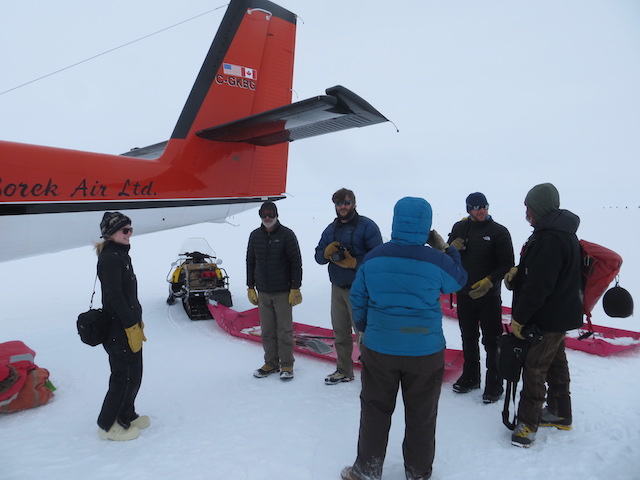 Preflight. Elina on the left, Mark on the far right and Andrew next to Mark. The others pictured helped us bring gear to the plane and send us off from camp. On the way to Evans Knoll, we flew over Pine Island Bay where Pine Island Glacier meets the sea. There are many large icebergs in this area. It’s quite a sight, especially in contrast to the flat white scenery of WAIS.
 Icebergs! 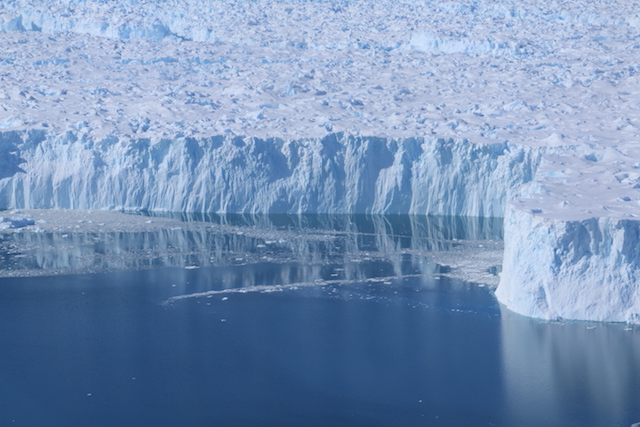 A wall of ice. 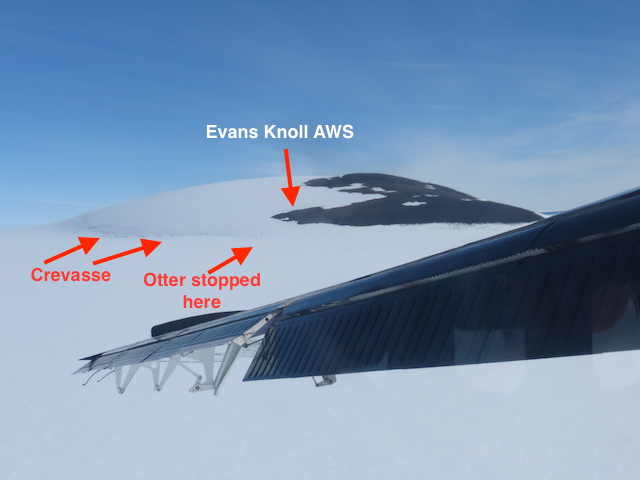 An aerial view of Evans Knoll as we approached, annotated for your convenience. I don’t think we could have picked a better day, weather-wise, to remove Evans Knoll. Light winds, “warm” temperatures around 27 F (~-3 C), and mostly clear skies.
After we landed at the base of the hill, Mark walked up to assess the crevasse as Elina, Andrew, and I organized our gear at the plane. Mark roped up and attached to a snow anchor below the crevasse before approaching the crevasse and probing the surface. He found a spot that was safe to cross, filled in the crack a bit with some snow to help solidify a “snow bridge”, then made a rope line that bridged the crevasse. As he hiked up the hill, he made several rope lines, all attached to anchors in the snow, that we would attach ourselves to as we ascended and descended the hill. This way, we would always be attached to a rope that would limit our fall and facilitate rescue if we were to fall into a crevasse.
 Harnessing up and prepping our gear before the ascent. 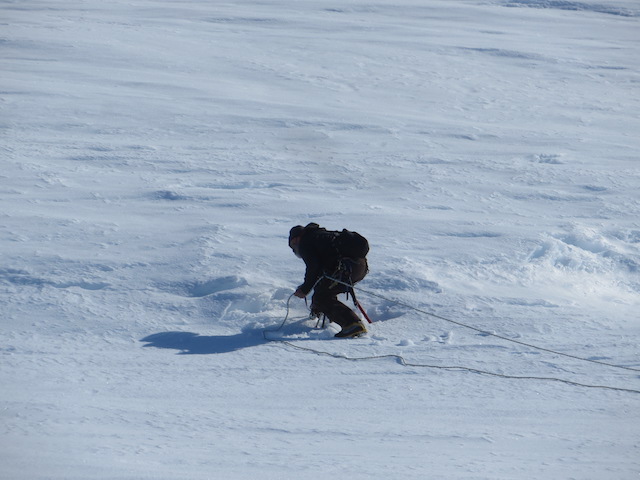 Mark checking the surface around the crevasse to get a sense of how wide it is. 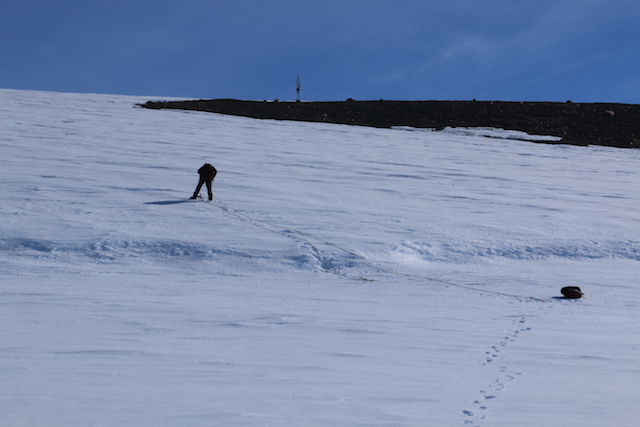 Mark above the crevasse, anchoring the rope to the snow. The first anchor is on the right, next to the bag. The AWS can be seen on top. Once Mark got the first two rope lines established, we started hauling our gear up the hill.
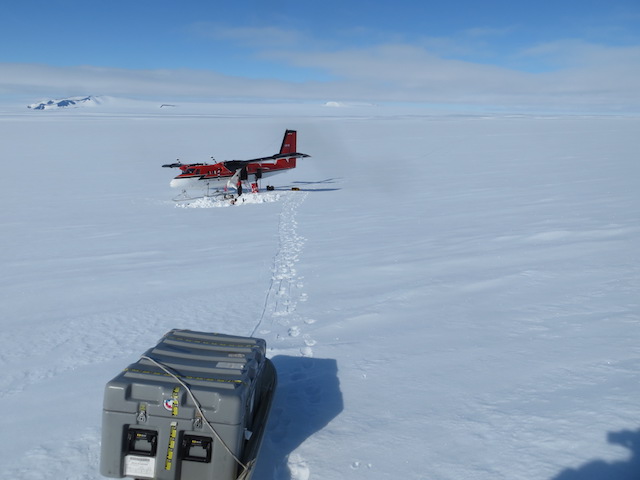 We used a banana sled to haul the gray Hardigg case up the hill. 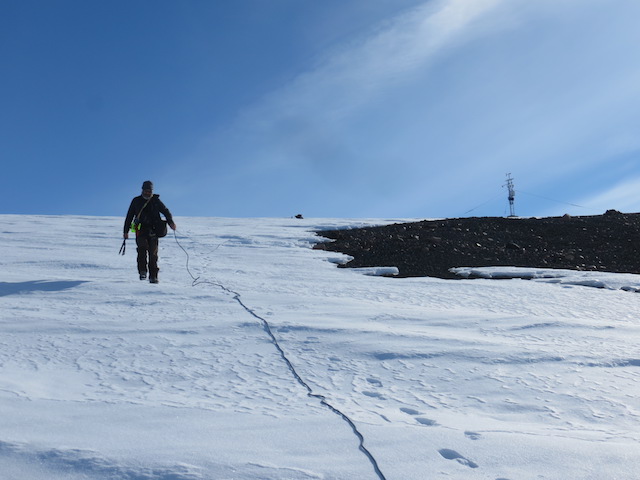 Mark finished the rope line! 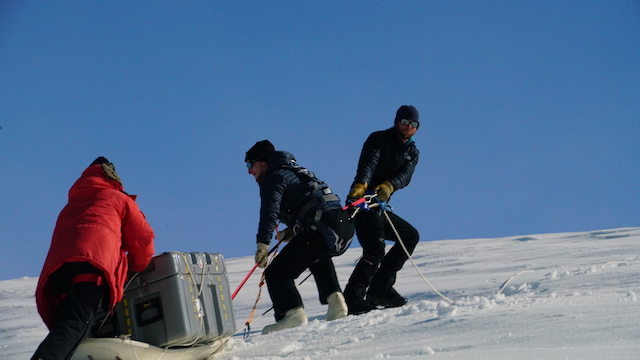 HEAVE! (Thanks for the pic, Mark!) It took us about an hour and 15 minutes to hike up the hill and reach the site. Once we did, Troy (Twin Otter captain) yelled up to us that if we wanted to go to Thurston Island, we had 1 hour to do our work here at Evans Knoll. We said “OK, you got it, Troy!” and got to work.
 Aaannndddd…. ACTION! (Thanks again, Mark.) It was a lot of fun as we frantically removed the instruments from the tower, loosened the guy wires, and removed the tower from the base plate. We all worked together and did our best to complete the removal as quickly as possible. One unforeseen hiccup was that the 2 battery boxes were frozen to rock at the base of the station, so that took quite a bit of time to chip them free. But we did!
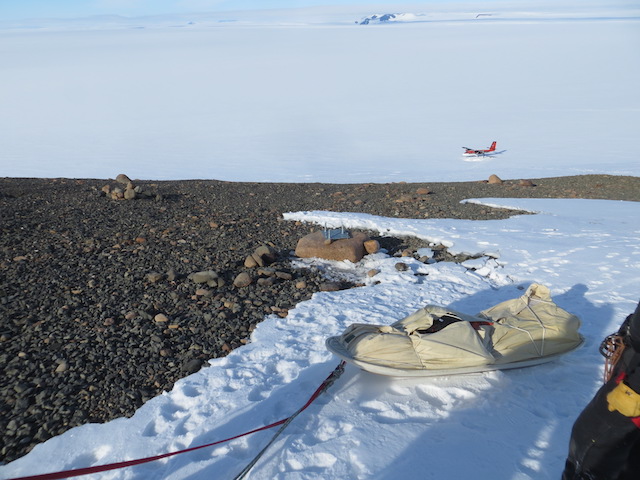 Evans Knoll is gone. It took a few trips to bring the gear back down the hill, and the rest of the gear is packed up on the banana sled here. 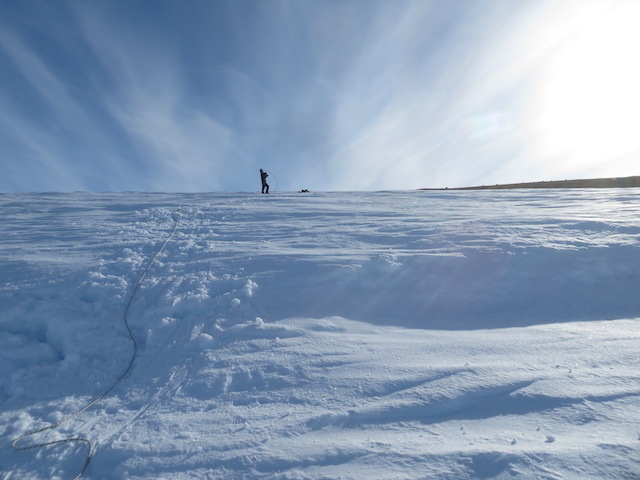 On the safe side of the crevasse again. Mark is removing the rope lines as he descends. We finished our work in enough time to go to Thurston Island! Our goal was to install a new Taylor high wind system on our AWS, as it gets very windy there and has consistently broken our wind monitors.
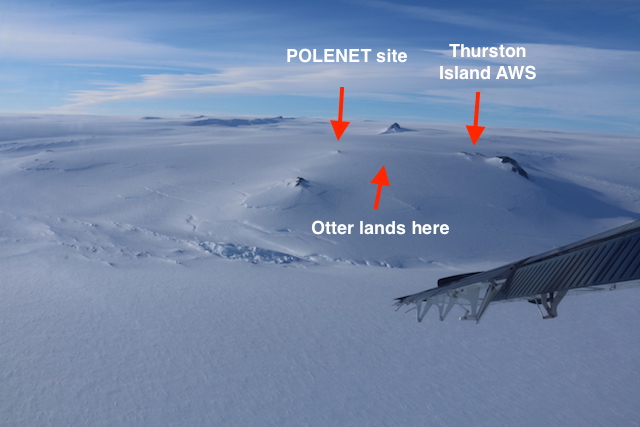 Aerial view of Thurston Island. It was partly cloudy at Thurston Island but windier than Evans Knoll. It was interesting to note, too, how much windier it was at the AWS itself than where we landed. Once we did land, of course, we had to haul our equipment to the AWS from the plane. Naturally, we used a banana sled again.
 Elina dragging the banana sled.  Thurston Island upon arrival. Note the wind monitor on the top is missing its propeller.  At our site, looking back towards POLENET’s site where the Otter is. Hi Elina!  Cool shadows. 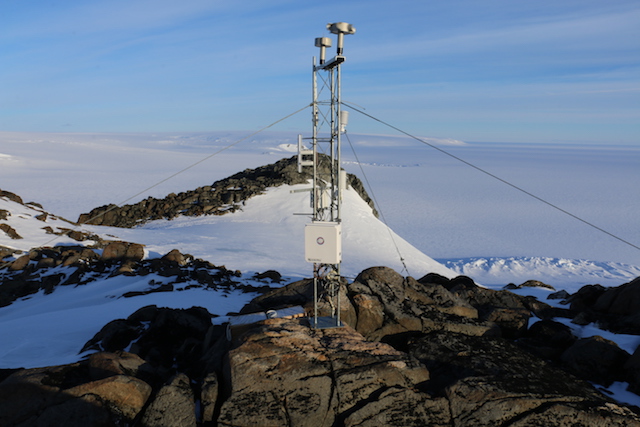 Thurston Island after we finished our work. The Taylor high wind system is installed on the top of the tower. The lighting during our visit was beautiful. It was late in the day, and since we were further North than WAIS, the sun was lower in the sky. This gave everything a nice hue towards the end of our visit. It was the closest to a sunset we’ve come in a long time!
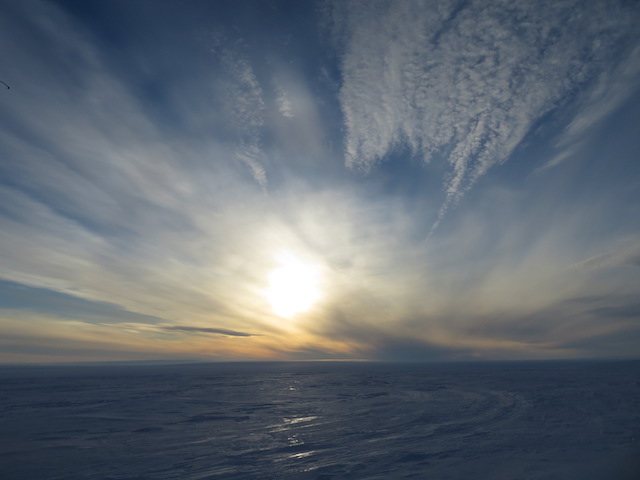 “Sunset” After a successful site visit for both us and Andrew, we headed back to WAIS. We needed to stop at the Turn 1 fuel cache, though, so we didn’t get back to camp until 9:30 pm. A long day, but a very productive and satisfying one! We saw some cool crevasses on the way back, too.
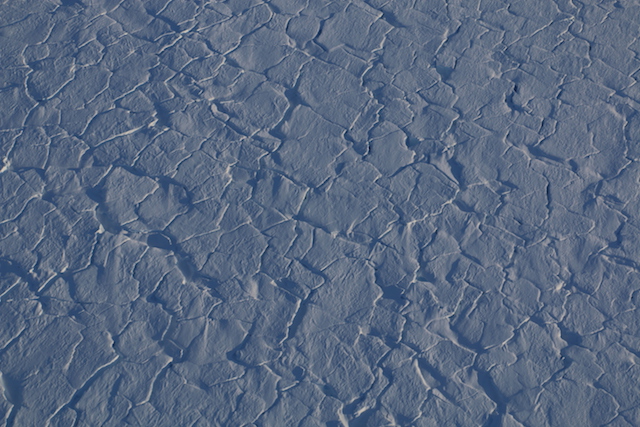 I think these crevasses resemble dry and cracked ground in a desert…  The low sun angle helped highlight these crevasses. Cheers! -Dave
At the time, we didn’t know it, but when we went to Austin on 12 January this began a stretch of very successful flights and field visits. Between 12 and 21 January, we visited the remaining 8 sites on our list in West Antarctica. That’s 8 sites in 10 days, but really 8 sites in 5 days of flying! Whew!
12 January was a good day of redemption. Elina and I felt compelled to get the visit to Austin completed (of course) but our Otter pilots, Jordan and Alex, were equally passionate about making it there. We all felt cheated by the cloud cover on our previous attempt. This time, the weather cooperated with us.
We departed WAIS at 7:45 am. One of the benefits of working at a field camp is that “transport” from the camp to the airfield takes all of 2 minutes. We can pretty much leave as soon as we’re ready. In McMurdo, we would need to wait for a shuttle to pick us up from Crary lab, then take the 30 to 45-minute drive out to the airfield before departing. But I digress….
On the flight to Austin, the Ellsworth Mountains are visible in the distance. They’re still quite far so it’s difficult to get a good picture, but given the flat and boring landscape at WAIS, seeing any topography carries that much more weight.
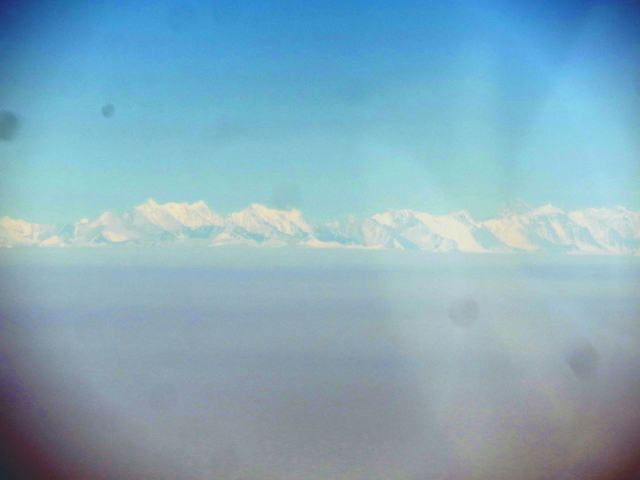 Part of the Ellsworth Mountains. I zoomed in quite a bit and did some post-processing on this picture… As before, we stopped at “Turn 1” fuel cache both to and from Austin. We arrived at Austin and were greeted to much better conditions than previous.
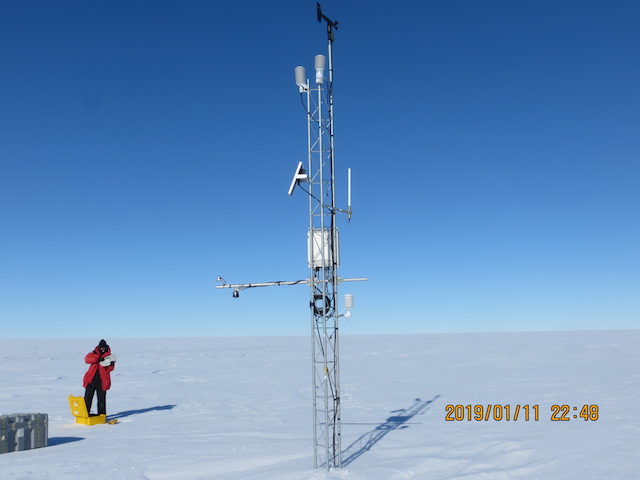 Austin upon arrival, with Elina getting the GPS powered on for the duration of the visit to record the coordinates and elevation of the site. The site visit went well. Austin gets a lot of accumulation, so despite raising the power system to the surface one year ago, it was buried about 5 feet down. We dug that out, brought it to the surface again, and swapped the batteries from the power system. It turned out the batteries had poor capacitance (ability to hold charge) so they were failing, and the station wasn’t transmitting. We also swapped the enclosure, just to be sure that we got the station working again. And it is!
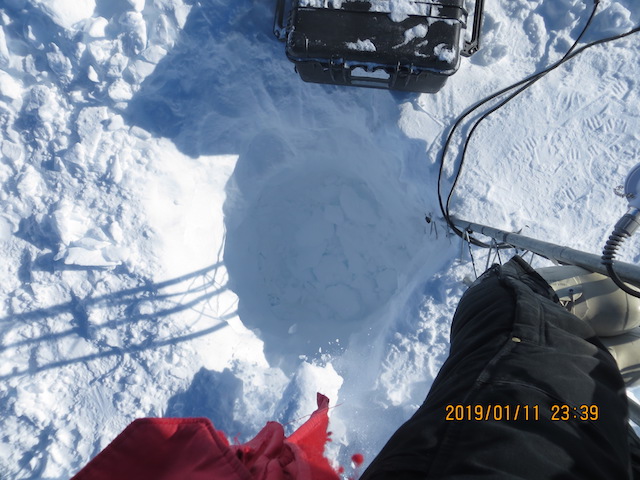 The hole to get the power system (black box at top of picture), taken while I was on the tower. 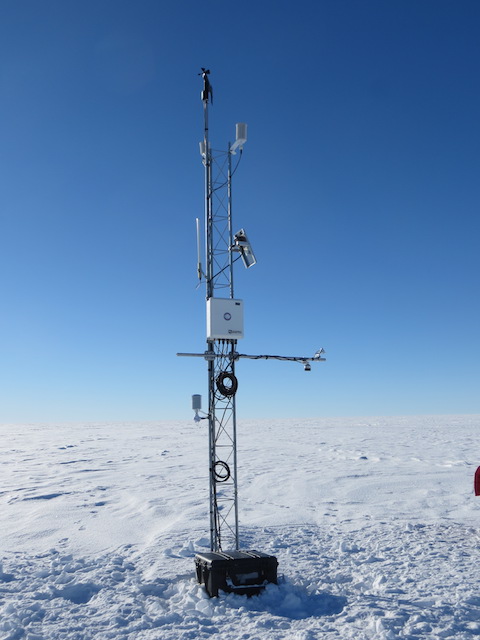 Austin after our work was completed. Cheers! -Dave
Elina and were getting antsy. We had now been at WAIS 9 days and hadn’t gotten to any of our planned sites. It’s nice that we got two extra site visits in, but we wanted to start checking sites off of our original to-do list. On 7 January, we finally got that opportunity, and it was even to visit our highest priority site, Bear Peninsula!
This site was highest priority because it is on the coast (far and usually bad weather), and we needed to replace a fraying guy wire. We also wanted to install a new Taylor high wind system, as the environment there is pretty rough on RM Young wind monitors.
Given all of this work we needed to do there, we had a lot of cargo to bring with us, including a generator, demolition hammer, and jerry can with fuel so we could chip out the large rock that has been fraying one of the guy wires. Fortunately, a couple people from camp, Andy Boyd (mountaineer) and Aurora Roth (PASSCAL), came with us and helped carry our gear from the plane to the site. The terrain makes it a difficult hike and carry cargo from the plane to the site, as we would need to walk up a hill that, for the first half, is snow and ice. The second half, where the site is located, is very rocky and uneven. Having extra hands was a huge help. It took us about 25 minutes to walk from the plane to our AWS.
 Bear Peninsula (this was taken at the end of the visit), showing the snowy/icy hill that leads to the rocky top of the hill. Our site is not pictured but is on the other side of the hill.  Bear Peninsula on arrival. Note the wind monitor is missing its propeller. It was a very nice day, with temperatures around 25 F and light winds, which did pick up a little bit during the visit but then decreased again. Everyone helped carry cargo from the plane to our site, then only Elina and I stayed to start the work as everyone else went back to the plane and the seismic site that Aurora had come to service. The first thing Elina and I did was chip out part of the large rock that was fraying the guy wire.
 The rock (left) causing all the issues.  The generator used to power the… 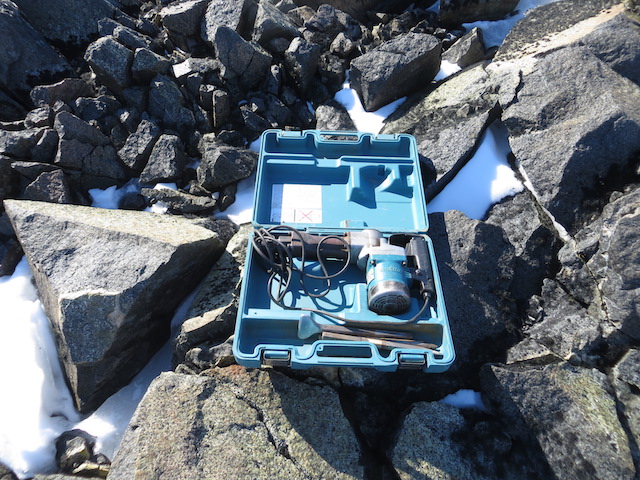 Demolition hammer! We used the demolition hammer as a chisel, but instead of needing to use a hammer to pound every strike, the demolition hammer does that automatically for us and at a much faster rate. It’s great! We were sure to wear safety glasses and cover our faces with a balaclava or neck gaiter, as lots of small bits of rock would fly up during demo-hammering.
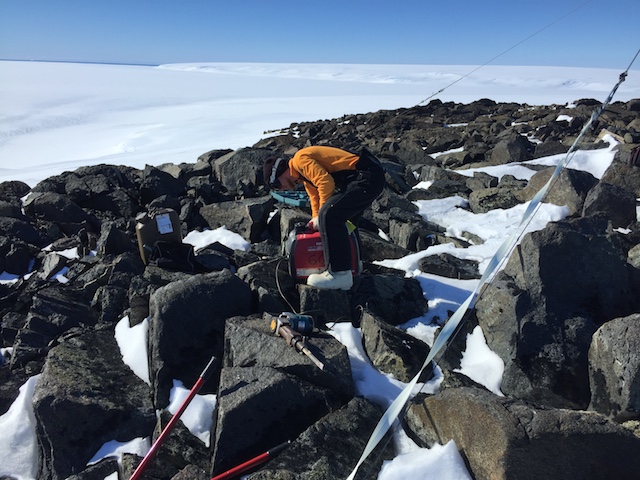 Me starting the generator. The demolition hammer is in the foreground, with the chisel piece attached. 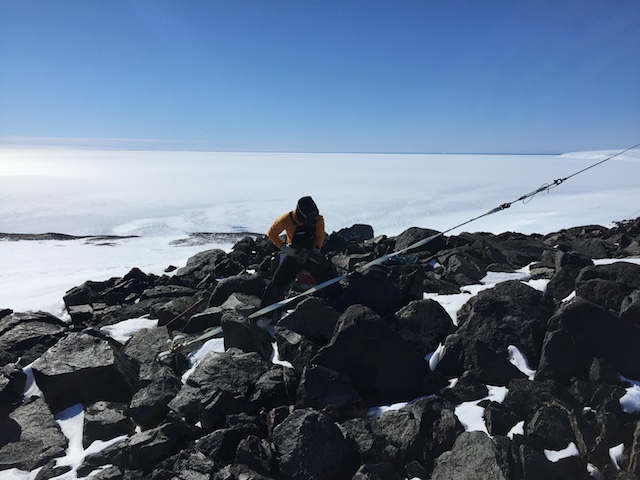 Me demolishing some rock. 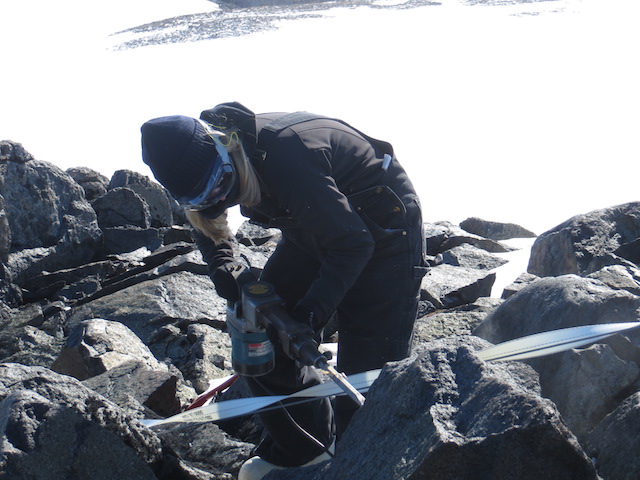 Elina demolishing some rock. It was very difficult to chip off sufficient rock (who knew??). One has to push pretty hard, straight into the rock, to make any progress. If you were at a poor angle, the hammer would just slide off the rock face. Once you started to make a dent/hole in the rock, it got easier to keep the hammer in the same spot. We essentially using the demo hammer to drill holes into the rock to weaken it, then chips of it would fall off. The whole process took about 30 minutes, but eventually we did it!
 The chipped-out rock. I don’t think it should present a problem with the guy wire any longer. Next, we needed to replace the bad guy with a new one (and remove the cargo strap that was acting as a fail-safe in case the guy wire snapped). At this point, everyone else had come back from the plane/seismic site to help and/or observe our work. Andy and I worked on installing the new guy wire while Elina worked on replacing some equipment on the tower and retrieving the CR1000 program.
 The new guy wire. We wanted to install new Taylor high wind system to replace the existing wind monitor which had broken a couple years ago (at least). Unfortunately, there was a plug mismatch between the cable plug and the enclosure, so we couldn’t install it. We removed the broken wind monitor anyways, as it wasn’t serving any purpose sitting on the tower. We did some other servicing at the site like swapping some radiation shields for the temperature and relative humidity sensors.
 Elina on the tower, with Andy and Aurora sitting on the ground. Soon after, everyone started to ferry gear back to the plane, and just like that we were done at Bear Peninsula.
 Bear Peninsula after our servicing. 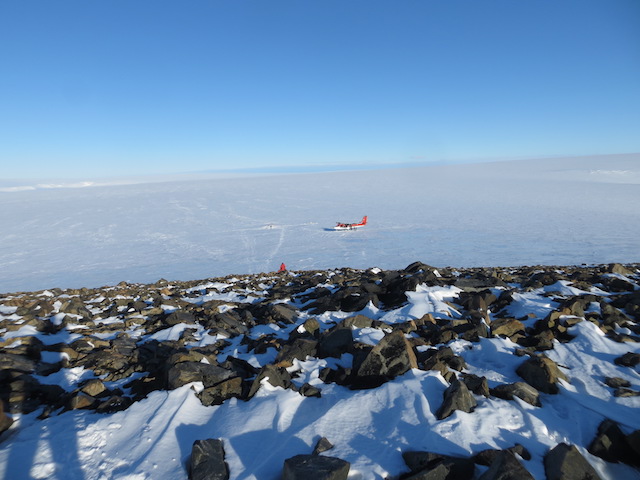 The view from the top of the hill, with the Otter at the base and Elina between me and the Otter. Cheers! -Dave
Austin is the second-furthest site from WAIS camp, with Thurston Island being the furthest. This is one reason why we had Austin as high on our priority list; it’s also not transmitting, so that’s a big reason, too. On the morning of 2 January, the forecast appeared to be good enough at Austin for us to do our work, so we headed that way. Due to the long flight, we needed to refuel on the way there and back at a fuel cache called Turn 1. It’s in the middle of nowhere, but sort of in the middle of many different sites in West Antarctica which makes it a useful location. It pretty much splits the distance between WAIS and Austin.
Both Otters were flying that day, with ours going to Austin and the other going to a POLENET site. We met up at the fuel cache on our way out!
 Turn 1 fuel cache. The barrels of fuel are between the planes. As we approached Austin, there was a thick, unbroken layer of cloud around 1000 feet above ground. The plane slowly descended below the cloud, and we were greeted to a wide expanse of flat light. It was nearly impossible to discern any surface definition. We ended up circling around Austin for half an hour. The pilots were hoping to find some semblance of surface definition so they could safely land.
Flat light conditions are very disorienting. As we were circling, it looked like we were flying between two very large, gray disks. One disk was the cloud layer above us, the other the ground below. At the horizon all around us was a thin layer of blue, where the cloud ended and we could see the sky.
For the first 15 minutes of our circling, I couldn’t tell whether there was a layer of fog or not at the surface. I also had no idea what our altitude was (turns out we were flying at around 500 feet), so when the plane would bank, it seemed like we were going to crash! Once, when the plane banked, it did it so smoothly that I couldn’t feel it. When I looked out my window and “down” I saw a line of blue. I thought that we were really close to the ground and the blue was a crevasse. I was incredibly confused. Then I realized what I was seeing was the blue sky at the horizon. It’s amazing what scenario your brain conjures up when you can’t get any bearings on what you’re seeing.
Only twice, and very briefly each time, was I able to see some sastrugi on the ground (turns out there wasn’t a layer of fog). The pilots never got a good enough view of the surface, so we had to boomerang back to WAIS. It was a huge bummer because we had made it all the way out to Austin, only to fly back. Alas, so goes Antarctic field work.
The next day, we weren’t on the Otter schedule. Weather was pretty good at WAIS, so we decided to take advantage of it and visit our site right near camp, Kominko-Slade. This site wasn’t on our planned list of visits, and as such it would be a very quick and easy visit to get some pictures and swap the data card. Since we both like to ski, I thought it would be cool to ski to the site. We were able to fit all the equipment we needed in a couple backpacks, and I wore my harness just in case I would need to be on the tower for a while. As far as I know, we are the first team to visit an AWS via skis!
 Me on the skis at Kominko-Slade. 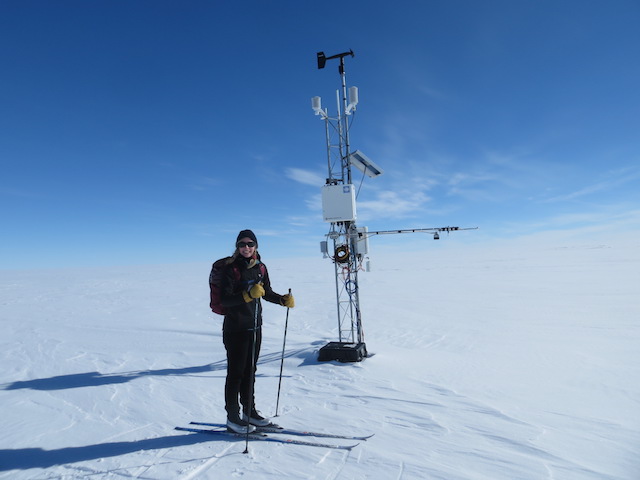 Elina after skiing to Kominko-Slade. Cheers! -Dave
Happy New Year from WAIS! All of camp (except the chef, Anna) had both New Year’s Eve and New Year’s Day off. We rang in the new year in style out here. Anna prepared a big feast for us, so we set up the galley for a family-style meal.
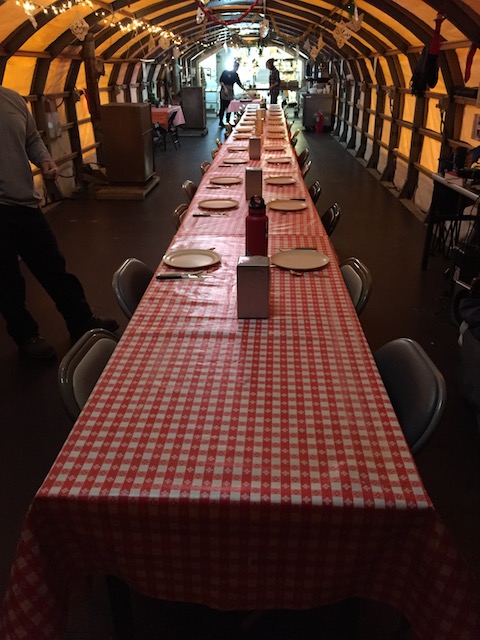 The long table! 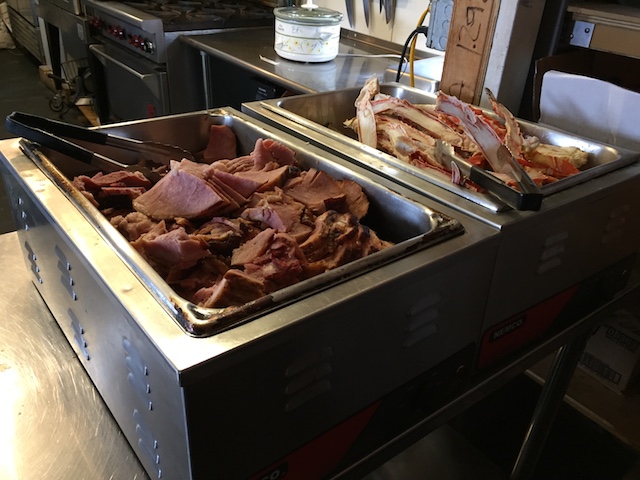 Ham and crab legs!  The assorted side dishes, including potatoes, roasted veggies, salmon, cheese, and crackers.  The bread and dessert table! So many good desserts, including babka on the near end of the table. Babka is a super tasty Russian dessert (the chef has Russian heritage). I think the dark swirls in the bread are composed of cinnamon and chocolate. After the feast, we all had time in the evening to relax and watch a movie or just hang around. We of course had a solid party we dubbed WAIS-stock (in response to McMurdo’s New Year’s concert/party Icestock) with music brought to you by one of the Otter pilots Jordan, also known as DJ Pedro. Needless to say, it was a blast.
New Year’s Day was easy-going, and I spent a portion of it biking on a fat-tire bike that was brought to camp.
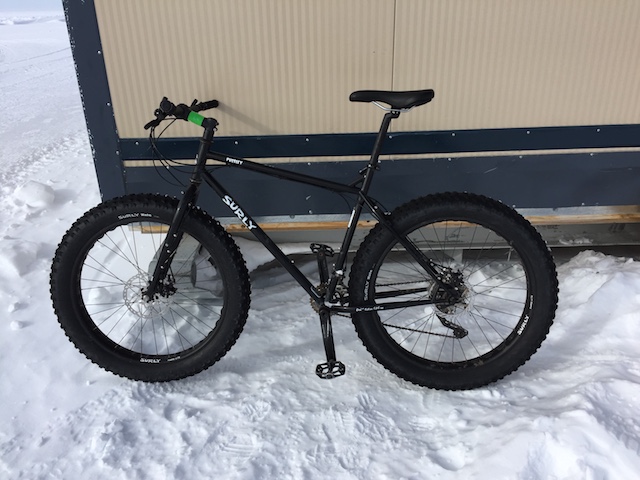 The fat-tire bike. One can bike pretty much anywhere around camp on this, though the heavy equipment (bulldozers, etc) make the snow in camp pretty bumpy. It’s nice to bike on the skiway, though, as that is a nicely groomed area.
Speaking of recreational activities, there are also skis available, so on a nice day when people don’t have much work to do, it’s often that someone will go skiing around camp or on the skiway. It’s nice to be able to get out of the tent(s) every once and a while!
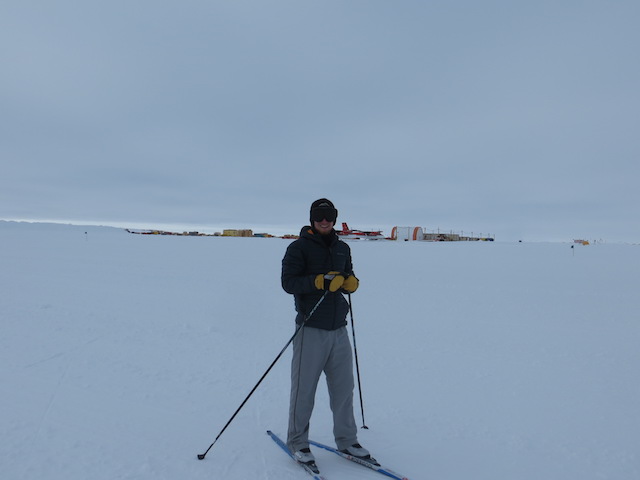 Me on skis on the skiway (Elina took the picture). Happy New Year! -Dave
The population of WAIS has been at around 30 people. This consists of the typical camp staff (manager, field coordinator, cargo coordinator, mechanic, heavy equipment operators, medic, weather observers, chef, etc), science groups (AWS, POLENET, PASSCAL, UNAVCO, and various Thwaites projects), and two Twin Otter crews (two pilots and an engineer each).
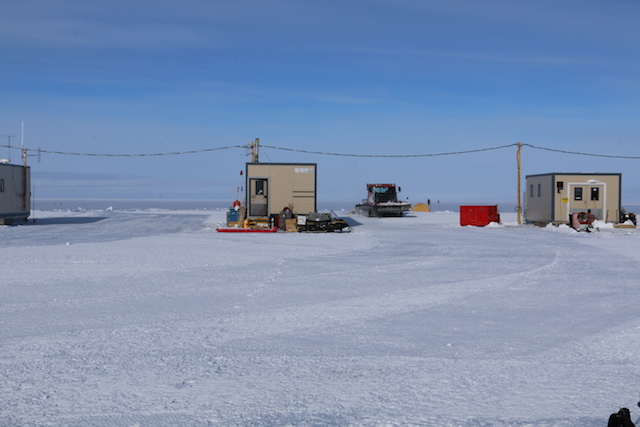 The Science Module (center), housing all science projects at WAIS. 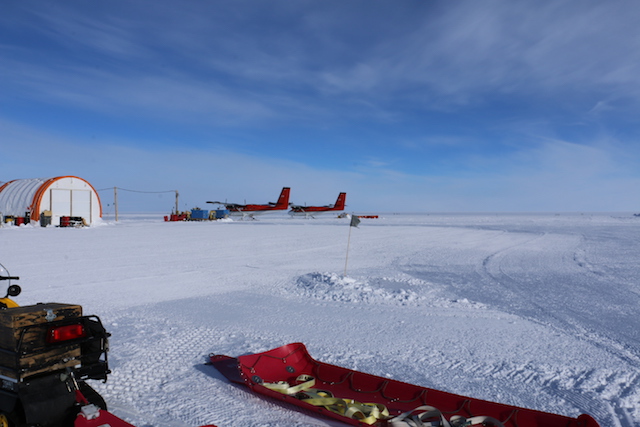 The two Twin Otters at camp. I took this picture from the snowmobile staging area. There are 4 snowmobiles available for general camp use. A typical work day for us involves waking up at around 6 am and meeting in the galley tent (where we eat) to get the weather report from the Otter pilots.
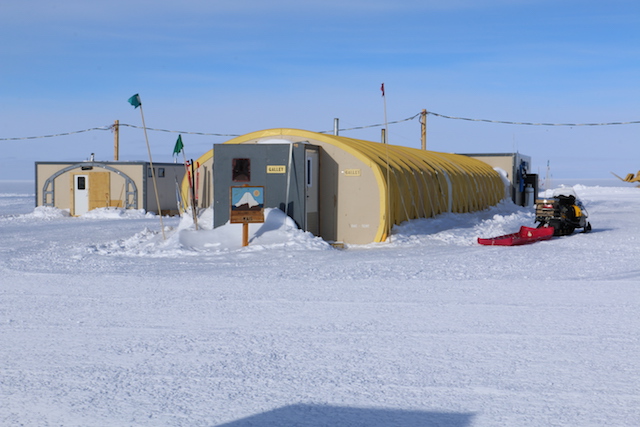 The galley from the outside. 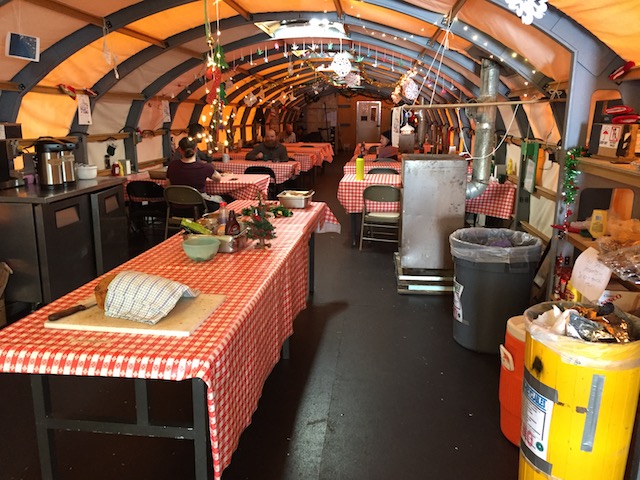 The galley, with decorations from Christmas still adorning the tent walls. The pilots typically talk with forecasters in McMurdo around this time to see how the weather looks both for WAIS and for the locations where we want to fly. We will have some coffee and a bite to eat as we discuss options for the day. If we aren’t a go (bummer), the morning then has a pretty relaxed vibe for us. We can sit and eat, chat, and eventually have the morning camp meeting where James, camp manager, leads a discussion of the day’s schedule of activities, flights, and the upcoming weather forecast. If we are a go (yay), then we make a flight lunch, pack some snacks, get all of our cargo ready, and load up the plane.
Today me, Elina, and some POLENET folks flew on an Otter to Byrd camp to help get Peter and Caleb back to WAIS, as they had finished their work at Byrd. Their plan then was to take a Herc flight from WAIS back to McMurdo. Since the Otter flight was already going to Byrd, we took the opportunity to service Byrd AWS near the camp. It was a very simple visit, as we just needed to swap the data card and dig up the power system to the surface.
There are only 3 people at Byrd camp this year, so the setup is much smaller than WAIS.
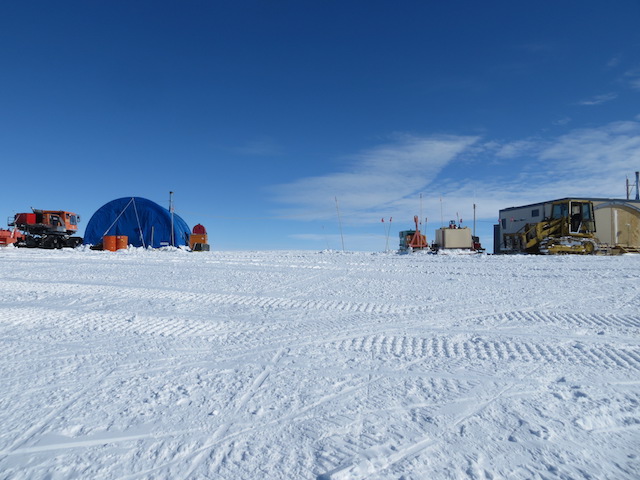 Byrd camp… It’s quaint. 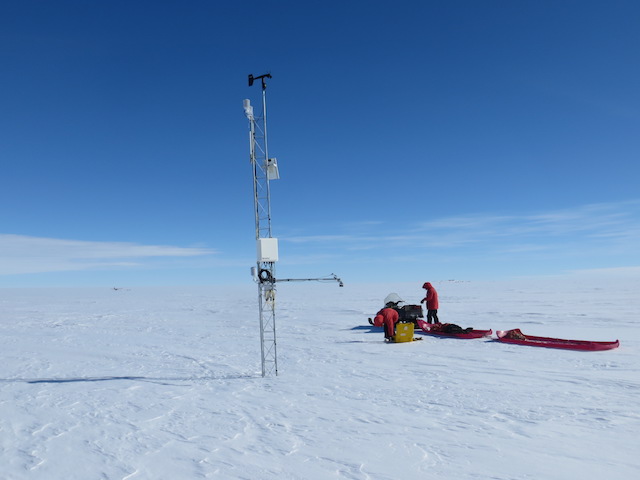 Byrd AWS on arrival. The Byrd camp weather observer, Jess (standing) snowmobiled Elina (crouching) and I to our site. Byrd camp can be seen on the horizon, to the right of Jess’ head (it’s very faint). The Otter at POLENET’s site, on the horizon and left of our AWS. We only had to dig down a couple of feet to reach the batteries, which was a pleasant surprise. After swapping the data card and slapping one of our stickers on the enclosure, we were done.
 Byrd after some TLC. The three of us then drove back to the POLENET site to check on their progress (they were almost done) then went to camp to have lunch! The Byrd camp staff offered to host us, which was very generous. They were also probably excited to see other humans…. The camp chef made very tasty burritos.
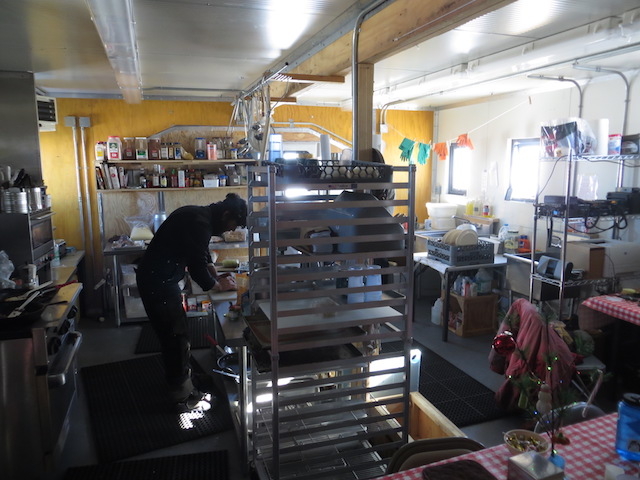 The Byrd kitchen, with Jonathan fixing up lunch for us. After a good meal and conversation, we loaded up the Otter and headed back to WAIS.
 A bird’s eye view of Byrd. Fuel bladders are on the left, cargo line and tent city in the middle, and the kitchen module and mechanics module on the right. Cheers! -Dave
Elina and I have returned to McMurdo from WAIS! Spoiler alert: it was a huge success! I wrote some blog posts out there about our experiences, so I’ll post them one at a time here, starting with our arrival to camp.
29 Dec 2018: Dave and Elina are at WAIS
It almost seemed like we were going to spend New Year’s in McMurdo. The town had both New Year’s Eve and Day off, meaning no flying on those days. The weather outlook appeared poor for flying on Sunday, 30 Dec. By Friday, 28 Dec, Elina and I were going to be on the next Herc (LC-130) out to WAIS and if we didn’t “bag drag” or get our cargo, luggage, and weights into the system by the end of the day, then we would fly on Sunday at the earliest, suggesting we wouldn’t make it to WAIS. But by around 3:30 in the afternoon on Friday, we finally got word that we were going to bag drag that Friday night for a 10 am departure on Saturday, 29 Dec. It all seemed so sudden, and one of the most miraculous things in USAP history happened: we made it out to WAIS on our first try! We left McMurdo an hour later than planned, but other than that, everything went smoothly as we got to WAIS early in the afternoon on Sunday. To boot, Elina and I got to spend the majority of our flight in the cockpit of the Herc, including during takeoff!
 Sitting in the cockpit of the Herc. 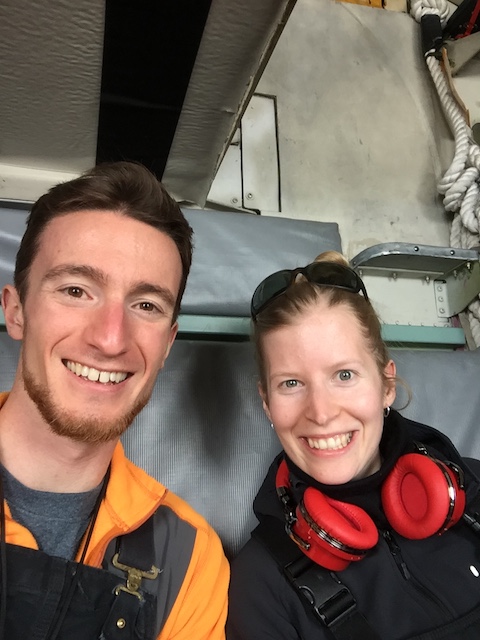 Proof positive.  Airborn! There were four passengers on the Herc: me, Elina, and two people with Communications, Peter and Caleb, who were trying to get to Byrd field camp, a little over 100 miles from WAIS, to set up communications equipment. The comms folks had been attempting to get to Byrd on their own Herc flight, but delays prevented them from doing so. Their plan was to take this Herc to WAIS and fly to Byrd on one of the Twin Otters at WAIS.
Before we knew it, we had arrived at WAIS. It was a nice day, mostly cloudy but not too bad. We couldn’t complain.
 Me and the Herc. 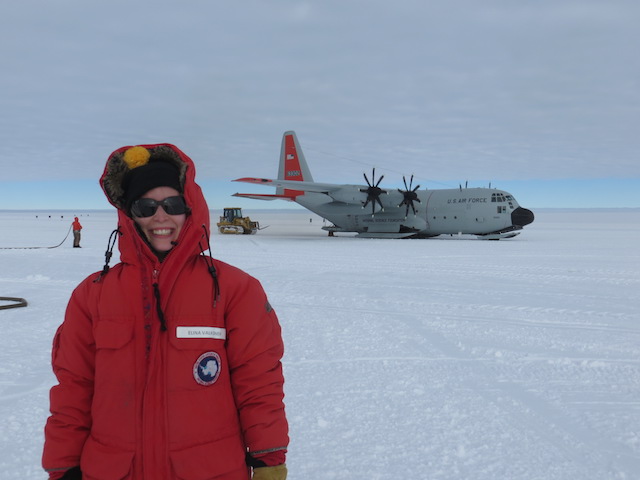 Elina and the Herc. We said hello to the camp manager, James, located our sleep kits (very important for optimal sleeping!), and went to the “Science Module” where we would work. The mod, as we call it, was already occupied by POLENET/PASSCAL/UNAVCO (6 people) and would be stuffed with a couple more science groups in about a week. Things were going to be tight!
 The mod, with Elina back in our designated corner. Once we got things settled, we got situated with our sleeping tents. Both of us opted to use Arctic Oven tents, rather than the mountain tents that were issued to us. The Arctic Ovens are bigger, and I think, a little more comfortable. Elina took one that was already set up but unoccupied, and I set up one with the help of Elina and the camp Physician’s Assistant (PA), Scott.
 My arctic oven tent. Due to the larger population this year, the camp location is different than last. Last year camp was kept on the winter-over storage berms (elevated mounds of snow), but this year it’s set up in the standard “summertime” location upwind of the berms. One benefit of this is that camp is mostly flat, rather than on a hill.
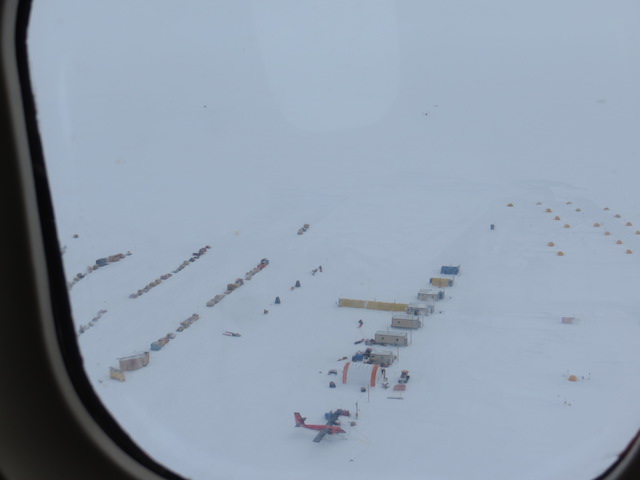 Bird’s eye view of most of WAIS camp, taken from the Otter. The main camp buildings are in the middle line, with the other Otter at the bottom. Cargo lines are on the left, and tent city is on the right. The winter-over berms are not pictured but to the left of everything shown here. Our plans here at WAIS are to visit 9 AWS sites by Twin Otter. There are fuel restrictions for our Twin Otter use due to the beginning of the Thwaites science project extravaganza, which is a 4-year effort between the United States Antarctic Program and the British Antarctic Survey to study the Thwaites glacier region, on the West Antarctic coast, with numerous projects. As such, we are only allotted 6 Otter flights. We’re planning on doubling up on some site visits for a flight or two to maximize our chances of visiting all AWS.
 Map of West Antarctica with our AWS sites. WAIS camp is at the Kominko-Slade (WAIS) marker. We hope to visit all AWS circled in magenta. The red polygon denotes the approximate extent of Thwaites Glacier, including the ice shelf on the far left end of the polygon. Cheers! -Dave
As promised, this post will be about our trip to Gill AWS, Lee and Mike’s trip to South Pole, and an update on the AWS team’s schedule (spoiler alert: Mike is on an LC-130 and redeploying as I write this!).
On 22 December, while Lee and Mike were at South Pole, Elina and I took a Twin Otter to Gill. We had been on the fixed wing schedule to visit Margaret first to raise the station, which is on the opposite side of the Ross Ice Shelf, and then make a quick stop at Gill to upload a new program. Margaret is notorious for having poor weather, as it is often covered in low clouds. The cloud cover on this day over the shelf didn’t look encouraging for any site visits, but we were put on weather hold for a couple hours. The thought was that maybe the clouds would clear up enough for a visit.
Turns out, they did! But only for Gill. We got contacted by fixed wing asking if we just wanted to go to Gill. We said yes, and since we had plenty of ground time, we had plenty of time to dig down and recover the power system, which was buried about 8 feet below the surface.
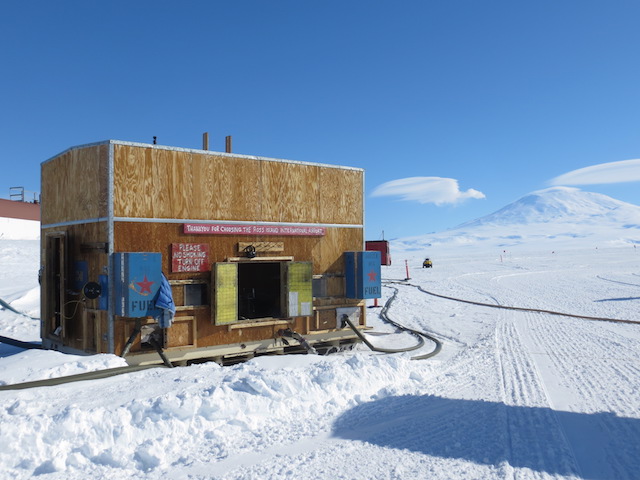 We topped off the Otter with fuel at Willie Field AKA “Ross Island International Airport”. 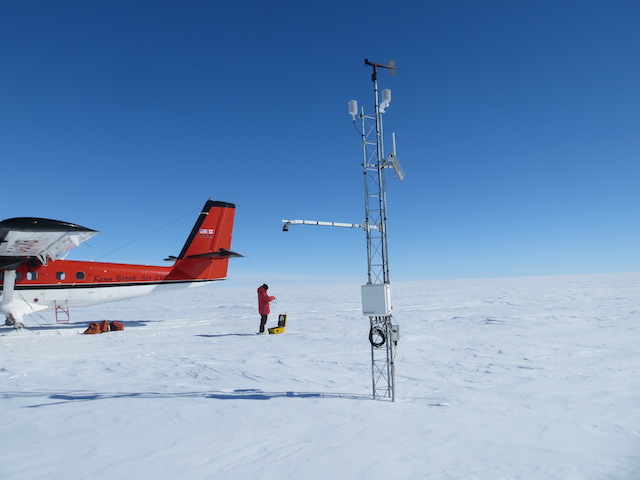 Gill upon arrival. We took pictures and got heights of the instruments then uploaded the new program. After that, we started digging and didn’t stop until we got the batteries! There were a couple instances when we were in the hole and it didn’t seem like we were ever going to reach them. But of course, we did. It was satisfying to bring them back to the surface.
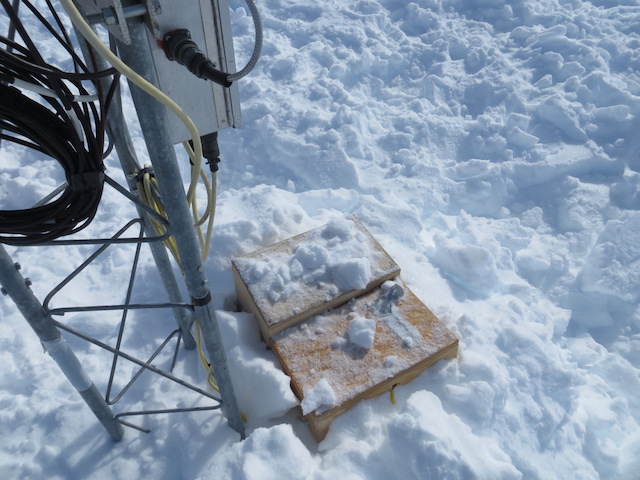 Beautiful battery boxes! 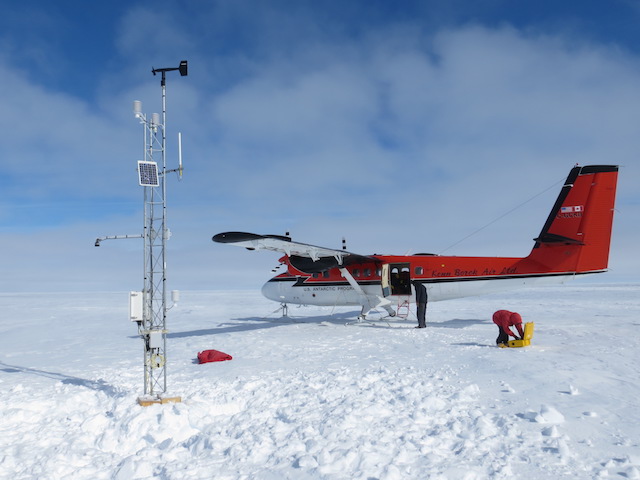 All done at Gill. While Elina and I were at Gill, Lee and Mike were at Henry near the South Pole! And a day prior, 21 Dec, Lee and Mike serviced Nico from Pole. These AWS hadn’t been visited since January 2015 when we did a station raise and upgraded their electronics from the older-style AWS2B to CR1000s. Mike wrote some good blog posts about those site visits, as well as their experience at South Pole Station, that you can check out here: https://www.polartrec.com/expeditions/antarctic-automatic-weather-stations-2018/journals . Their main objectives at both sites were to replace the enclosures, power systems, and upper temperature aspirated shields. Lee said the fan on the aspirated shield at Nico was still running, which is amazing! Here are some pictures from their site visits, too:
 Nico upon arrival.  Nico after. They did a lot of digging! 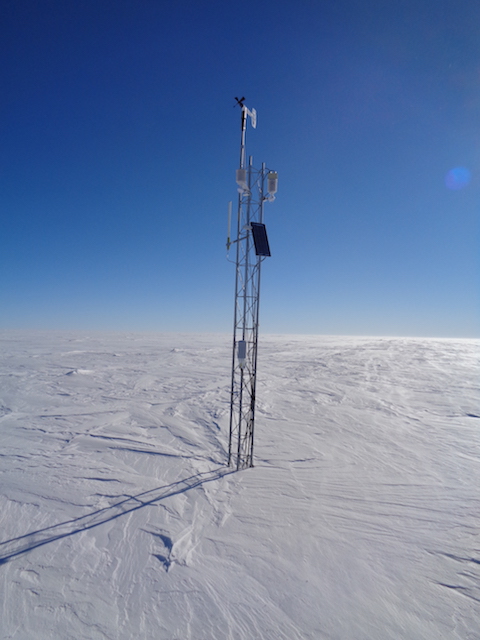 Henry upon arrival. 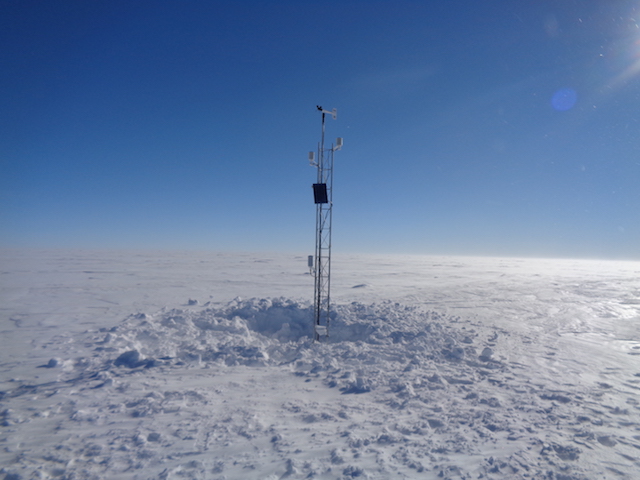 Henry after servicing. Switching gears a bit, Elina and I will be heading out to West Antarctic Ice Sheet (WAIS) field camp soon (maybe even tomorrow, 28 Dec). Plans seem to be up in the air at the moment, as we’ve been asked if we wanted to leave a couple days earlier than our originally planned departure date, 29 Dec, but delays have pushed things back. If we do fly to WAIS tomorrow, there won’t be any internet connection for us, and as such I won’t be able to post any updates until we return to McMurdo. I’ll still write blog posts out there describing our work and experiences and post them when we return, which will probably be around January 20th. Our goal is to visit 9 AWS sites, but we only have 6 Twin Otter flights allotted to us due to fuel limitations. Hopefully we will be able to double up on site visits for a couple of the flights.
In McMurdo, Lee and Forbes will be working on preparations for installing the 4 PCWS in the McMurdo area and doing what AWS service work they can. Currently, we are not on the Twin Otter schedule in McMurdo, and since we’re waiting on getting some modems activated for our site visits by helicopter, we’re in stand-by mode. Hopefully things can pick up soon and they can get site visits completed.
Cheers! -Dave
Happy Holidays, all! The whole AWS team was together in McMurdo to celebrate the Christmas holiday! It’s been a while since I’ve updated this, and for that I apologize. There has been many developments, especially in the past 5 days. Lee and Mike made it to South Pole Station after a week of delays, and they were even able to complete the 2 site visits to Henry and Nico and make it back to McMurdo in time for Christmas! I’ll try to post a couple blog posts detailing the events the have recently transpired.
 The five of us as we wait in line for the Christmas feast. Every year, McMurdo has a holiday feast (for both Thanksgiving and Christmas) where they feature some specialty dishes, including prime rib, lobster, crab, and a great assortment of desserts. It’s always a great time, and as we were eating we were treated to some snow! A white Christmas in McMurdo!
 The feast! We enjoyed it with members from IRIS/PASSCAL and UNAVCO, projects with whom we work alongside here on the ice. 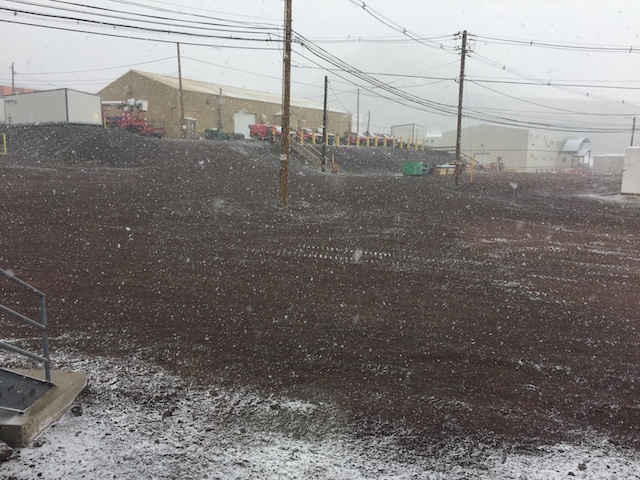 Christmas snow!  They even had the yule log, and of course, a Christmas tree. Some quick group and schedule updates: Mike is due to redeploy on Thursday, December 27. Elina and I will probably start trying to head to WAIS at the end of this week. As I mentioned previously, Lee and Mike finished the field work at Nico and Henry, but the new PCWS was unfortunately not ready in time for install at South Pole. Out of McMurdo, Elina and Dave took a Twin Otter flight to Gill (Margaret has been consistently canceled due to weather, no surprise there haha).
That’s all I have for now. Cheers! -Dave
Yesterday, 12 December, Elina, Forbes, and I took a helo trip to Ferrell to raise the lower instrumentation and dig up the power system. We had two boondogglers come along with us: Megan and Cat. They work in town in McMurdo and don’t get many opportunities to get out in the field. We’re always happy to spread the joy of visiting our sites to others! Also, this is Forbes’ first site visit!
The weather throughout the visit was great; sunny skies the whole time, and a light wind turning calm. We had a little over 4 hours of ground time (which was plenty), as the helicopter dropped us off and went to fly other missions. We determined that we did not need to add a new tower section, so that made the work that much simpler.
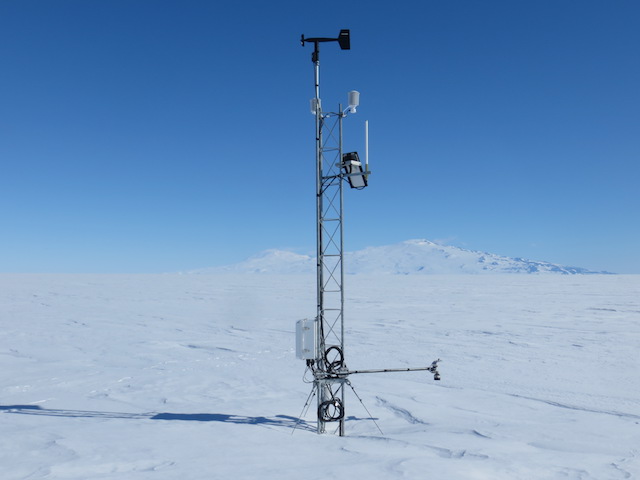 Ferrell upon arrival. Ross Island is in the background. After taking pictures and measuring instrument heights, we got to work digging and removing the lower temperature, instrument boom, and enclosure from the tower. The power system was buried about 5 feet below the surface. Forbes was probably the star digger of the day, as he spent the most time in the pit and did a great job lifting the power system up to the surface. The power system consists of two 100 Am-hour batteries, each of which weighing about 70 lbs. We removed one of the batteries from the box before Forbes lifted the power system out.
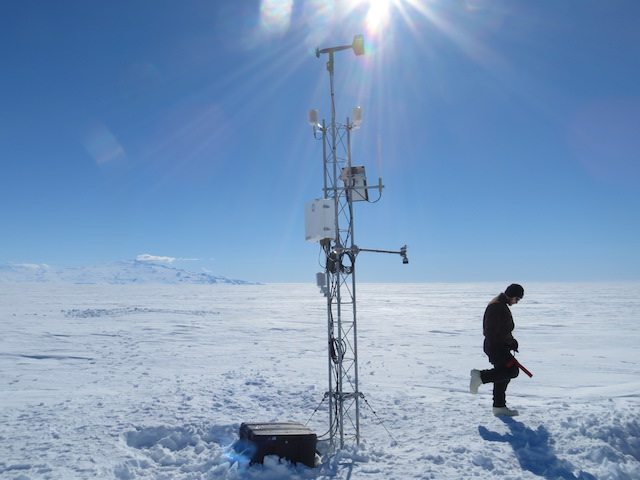 Ferrell after the raise, and Forbes on the right. It was a leisurely field visit, as we could go at a relatively slow pace to do the work as we were not pressured by time or weather. Since there wasn’t much physical work to do, Elina decided to dig a hole simply to stay warm. Megan decided to dig on as well, and since the two holes were close in proximity, they dug out a tunnel to connect the two! Some very rigorous science took place at Ferrell AWS yesterday….
 Elina in her hole! 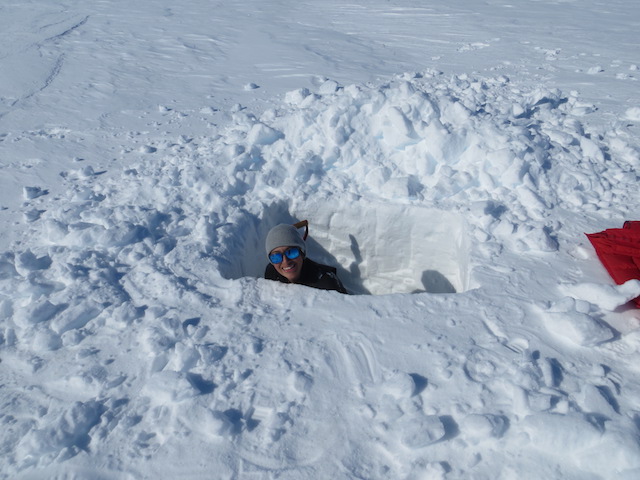 Megan in her (impressively square) hole! 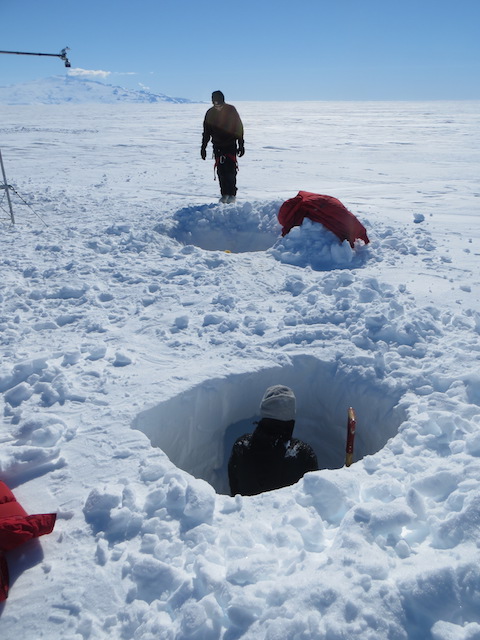 The hole setup.  The spike of the ice axe, indicating first contact between the holes. They eventually made the tunnel large enough for us to crawl through! That’s all for now. We’re currently on the Otter schedule to fly to Margaret and Gill, but we’ve been weather-canceled thus far. Hopefully tomorrow will bring sunnier skies. Cheers! -Dave
|
|
























































































